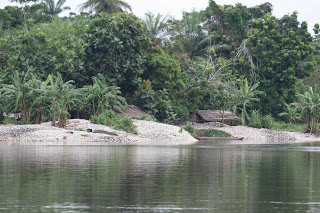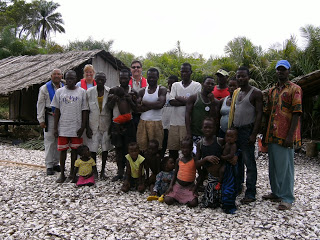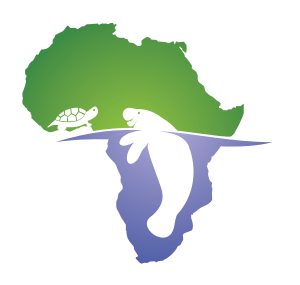A Day of Drifting and the Manatee Hunter
On Sunday I went back up the Congo River, once again hoping to see manatees. By now I’ve started to get a pretty good sense of the area. We go up the main river for about an hour before turning off into a tributary.
Heading up the Congo River from the mouth, in the early morning calm
At the mouth of the tributary is an Angolan navy outpost where we check in. On Sunday a navy guy came over and excitedly told us they had just seen a manatee go by, heading up the tributary. So we motored up a short distance, turned off the engine and drifted, but we never saw it. The river was very deep, 17-22m. We headed upriver past Kibaka and returned to a village called Nzadi Caca. There are actually two villages across the river from each other, all built on large mounds of clam shells. Not surprisingly, the large freshwater clams are the main food and livelihood of the villages in this area. The men free dive as deep as 16m in the river to get the clams, which they tell me the manatees eat as well (they specified that manatees only eat rotten or baby clams, presumably because they can actually get them out of their shells). Clams have been found in manatee stomach samples from northern Africa, so it was interesting to hear it described here as well. Joao bought some clams from the village and I tried one… unfortunately the kindest way to describe the taste was salted sediment.
A village across from Nzadi Caca built on millions of clam shells Skewers of clams being smoked at Nzadi Caca
Skewers of clams being smoked at Nzadi Caca Villagers at Nzadi Caca frequently see manatees and were very helpful in describing behaviors they observe. My fantastic translator Joao and I are on the back left, and Mike Carpenter from Angola LNG is also in back (photo credit goes to Mike!).
Villagers at Nzadi Caca frequently see manatees and were very helpful in describing behaviors they observe. My fantastic translator Joao and I are on the back left, and Mike Carpenter from Angola LNG is also in back (photo credit goes to Mike!).
After leaving Nzadi Caca we drifted downstream for awhile, once again hoping to catch a glimpse of a manatee. But this day was a reminder that we had been incredibly lucky last Thursday, because we didn’t see any all day. However, today there were also a lot more motorized boats heading upstream, all filled with gas drums headed for the Congo.
On our way back down the main river to base, we passed the town where the manatee hunter lives. There were several fishing boats out in front, so we asked a fisherman if the manatee hunter was there. He said yes, he was a short distance away on another boat. He paddled over to us and we were able to interview him (with Joao translating). The manatee hunter is named Sebastian and he has lived in this village his entire life except from 1955-1958, when he was sent to India with the Angolan army. He is an old man now but still hunts both manatees and crocodiles. He showed us his harpoons and net and gave a lot of good information about manatees. Although it is depressing that he is killing manatees, these interviews have to remain completely non-judgmental if I’m going to gain trust and get good information. He does have some bones in his village and hopefully next time I will be able to convince him to let me take samples for genetics.
Sebastian and one of his harpoons. He uses one (with bouy attached) to initially harpoon and then follow the manatee, and he has another 2 harpoons to finish the job. Fishermen display the manatee capture net.
Fishermen display the manatee capture net. Joao and I interviewing the manatee hunter (photo: Mike Carpenter)
Joao and I interviewing the manatee hunter (photo: Mike Carpenter)

